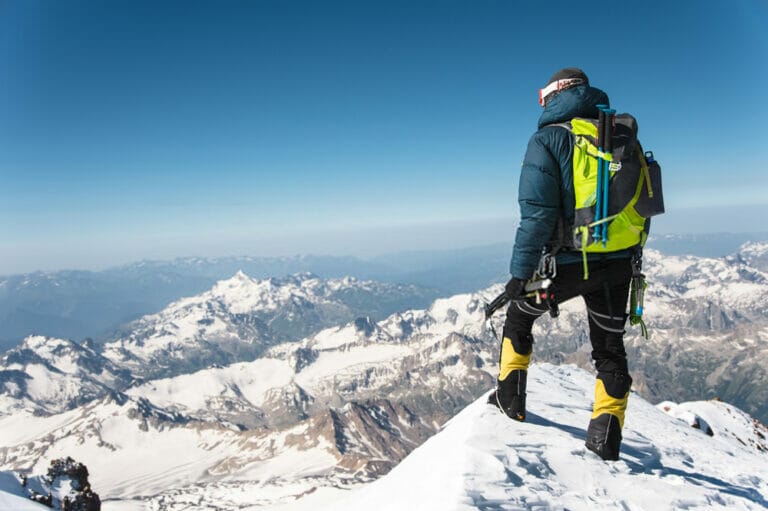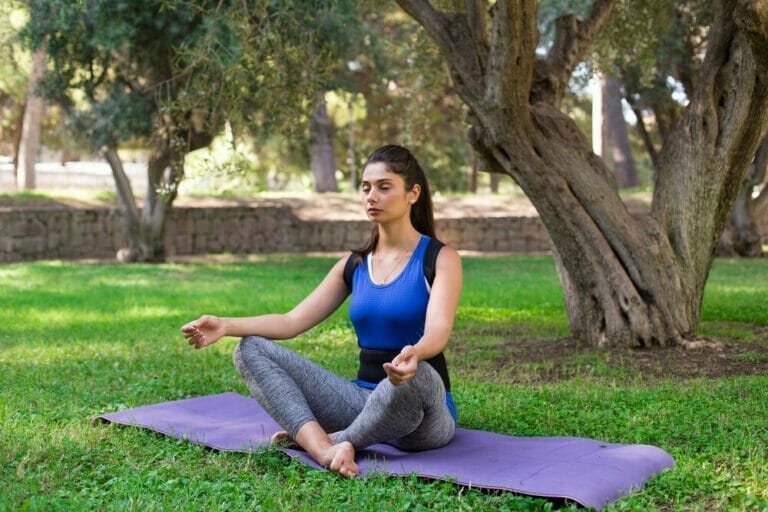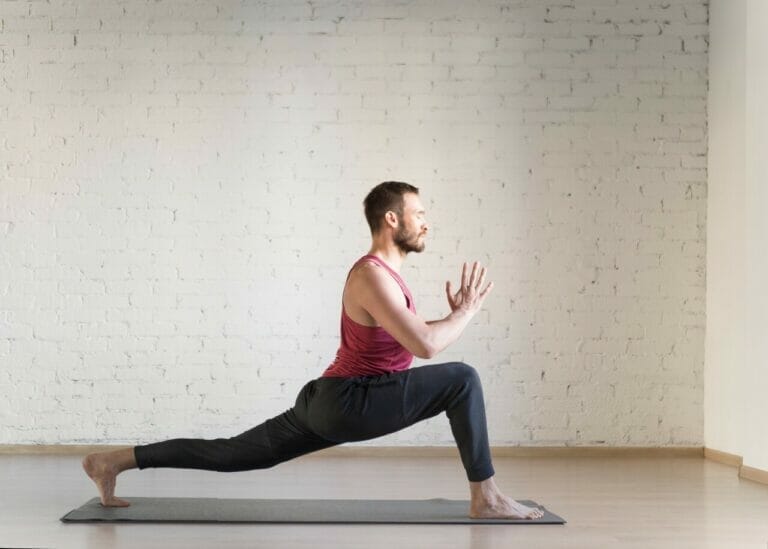Hot Bikram Yoga 26 Poses Sequence To Get Started Right Away
Yoga in a hot room? This sounds like a recipe for disaster, but it could be your ticket to a new life. Bikram yoga 26 poses is a hot practice, which means exercising in the most comfortable environment possible.
So what is bikram yoga? Bikram yoga is a popular form of yoga that was founded in the 1970s by Bikram Choudhury. Bikram yoga consists of hot 26 yoga poses, including two breathing exercises.
This yoga class is performed in a "hot room" heated to 105°F (40°C).
Bikram 26 poses sequence is a very intense practice that is characterized by fast, dynamic movements and deep stretching. You will sweat profusely in this class because it involves intense physical exercise.
However, you will also feel energized after doing a bikram hot yoga sequence because of the heat and the post-class shower.
The thing about bikram yoga postures is that it is easy. This style of yoga will help you understand your body, how you learn and how you work best.
Bikram Yoga 26 Poses: Hot 26 Yoga Poses
The thing about Bikram Yoga is that it is easy. This style of yoga will help you understand your body, how you learn and how you work best.
Related Posts:
- Different Types Of Yoga For Beginners For Body Mind & Soul
- All About Yoga – Its History, Types, Uses And Many More
- All You Need To Know About Vinyasa Yoga
- Bikram Yoga – All That You Need To Know!
- Ashtanga Yoga
- The Amazing Health Benefits Of Doing Yoga
Below, we have mentioned the bikram 26 poses sequence:
PRANAYAMA (STANDING DEEP BREATHING)
Pranayama is a breathing exercise in yoga. This bikram 26 poses sequence commences with a standing position and a breathing exercise. Deep inhales and exhales increase oxygen flow, circulation, and focus.

In addition, by expanding the belly and contracting the muscles in the back, you can clear out toxins and heavy metals from your system.
ARDHA CHANDRASANA – PADAHASTASANA (HALF MOON/HANDS TO FEED POSE)
This bikram hot yoga sequence has three parts; the half-moon side bend, the half-moon backbend, and it is combined with the hands to feet pose.
The side bend is the preparation for the backbend. The backbend is an essential part of any yoga sequence.
Hands to feet pose a forward bending stretch whereby the goal is to bend at the hips and stretch the entire length of the spine.
The name is different in bikram yoga postures than in other yoga styles, where this pose is called Standing Side Stretch.
Benefits:
- Improves posture and lower-back pain
- Strengthens thighs, calves, and all of the body’s central muscles
- Opens the hips and increases flexibility
- Stretches and strengthens the spine
- Improves digestion, sleep, and respiration
- Increases spinal flexibility
UTKATASANA (AWKWARD POSE)
It is a three-part series of exercises that will strengthen your muscles. In this position, your feet can move freely without shoes on.
This pose is often attributed to as Chair Pose in other lineages of yoga. This pose strengthens the lower body while increasing blood circulation.
Benefits:
- Heals chronically cold feet
- Alleviates rheumatism and arthritis in legs
- Circulates fresh blood to knees and ankles
- Strengthens and firms muscles of legs and upper arms
- Helps cure slipped discs and other lower-spine problems
- Increases hip flexibility and relieves muscular aches and cramps
GARURASANA (EAGLE POSE)
This posture challenges your balance. However, this exercise is effective because it has the power to stretch, strengthen, and provide mobility in all major joints.
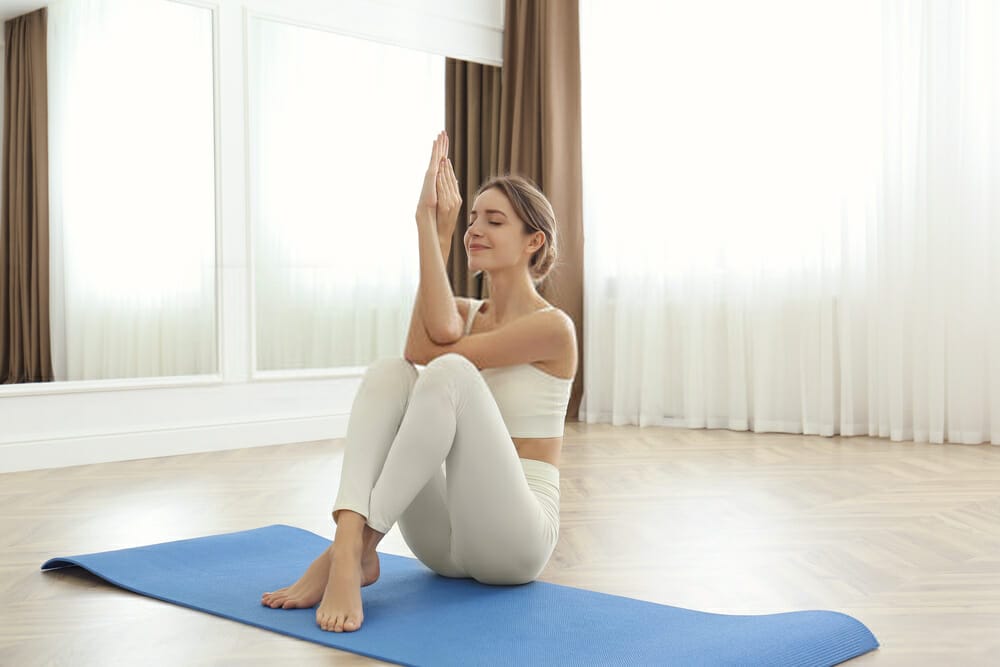
Benefits:
- Warms the body and readies it for the following three poses
- Enhances lymphatic functions
- Strengthens deltoid, trapezius, and legs
- Reduces varicose veins
- Promotes the health of the central nervous system
- Improves balance, hip-joint mobility, and immune system
DANDAYAMANA – JANUSHIRASANA (STANDING HEAD TO KNEE POSE)
In this pose, you focus on your knee, stretching your tendons and opening the back of your knee. The fluids in your cartilage could reach the entire cartilage, and it will sustain and rebuild it.
As we age, our joints become dry and less functional. Our bodies also start to degrade with age and produce more harmful crystals that grind away the cartilage.
A difference is that in bikram yoga postures, they are just dissolved back into the fluid.
In Bikram’s words, this requires “Bengal tiger strength” and “English bulldog determination”. First, you have to beat the demon within, which will be a boon out in the world. You are more powerful than you suppose, for you can do it.
Benefits:
- Improves concentration and mental strength
- Tightens abdominal and thigh muscles
- Lessons/mitigates diabetic disorders
- Increases flexibility of sciatic nerves
- Strengthens the Tendons, hamstrings, and biceps of thigh muscles
DANDAYAMANA – DHANURASANA (STANDING BOW PULLING POSE)
It is a favored pose for those who could never have the dream of being a ballerina. This pose increases strength and flexibility in the body and increases attention and patience.
In addition, this bikram hot yoga sequence promotes the idea that this pose is the only posture that helps blood flow from one side of the body to the other, equalizing circulation.
Benefits:
- Stimulates cardiovascular system
- Improves flexibility and strength of most of the body’s muscles
- Opens shoulder joints and diaphragm
- Eases frozen-shoulder conditions
- Enhances spinal elasticity
- Firms abdominal wall and upper thighs
- Tightens buttocks, hips, and upper arms
- Increases elasticity and size of lungs and rib cage
- Reduces abdominal fat
- Improves flexibility and strength of the lower spine
- Increases circulation to heart and lungs
TULADANDASANA (BALANCING STICK POSE)
This pose in the bikram hot yoga sequence is Tuladandasana, also called Balancing Stick Pose. You need balance, determination, and core strength in this pose.
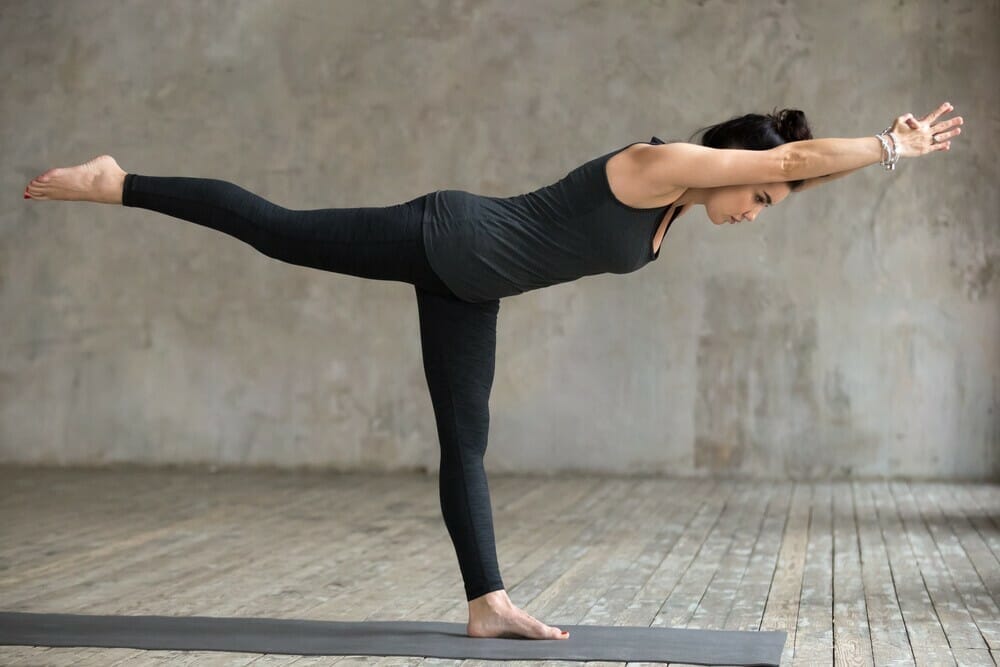
This position increases circulation to the heart and brain, and is commonly practised in other styles of yoga by the name of Warrior Pose.
Benefits:
- Increases cardiovascular circulation, especially to blood vessels of the heart
- Improves posture
- Refines control and balance by enhancing physical and mental powers
- Relieves spinal stress
- Reduces varicose veins
- Exercises liver, pancreas, spleen, and circulatory and nervous systems
DANDAYAMANA – BIBHAKTAPADA – PASCHIMOTTHANASANA (STANDING SEPARATE LEG STRETCHING POSE)
Take a break from balancing with standing Separate Leg Stretching Pose. This pose stretches the thighs, spinal muscles, and specifically one’s sciatic nerve.
You may be familiar with this position in other yoga classes as Wide-Legged Standing Forward Fold.
Benefits:
- Cures and prevents sciatica
- Increases flexibility of bottom five vertebrae
- Boosts circulation to the brain and adrenal glands
- Improves functioning of most internal abdominal organs, tiny and large intestines
- Mitigates diseases of the nervous system and effects of constipation, diabetes, and hyperacidity
- Reduces abdominal obesity
- Enhances flexibility and muscle tone of ankles, calves, thighs, pelvis, and hip joints
- Releases lower back
- May alleviate depression
TRIKONASANA (TRIANGLE POSE)
It is a challenging posture. You balance on your right leg and stretch your left out in front with your arms outstretched in this pose. This pose is known as Extended Triangle Pose in other lineages of yoga.
Benefits:
- Improves flexibility in legs, hips, and chest
- Builds core stability
- Strengthens arms, shoulders, and triceps of the upper arm
- May relieve sinusitis
- Opens shoulder joint and alleviates frozen shoulder
- Strengthens and tones buttocks and legs
- Aids in regulating hormonal levels
- Provides cardiovascular exercise
- Reduces saddlebags
DANDAYAMANA – BIBHAKTAPADA – JANUSHIRASANA (STANDING SEPARATE LEG HEAD TO KNEE POSE)
The practice of this yoga posture is done to increase metabolism and massage the internal organs.
If you aren’t a Bikram student, you may have practised a similar version of this pose called Intense Side Stretch.
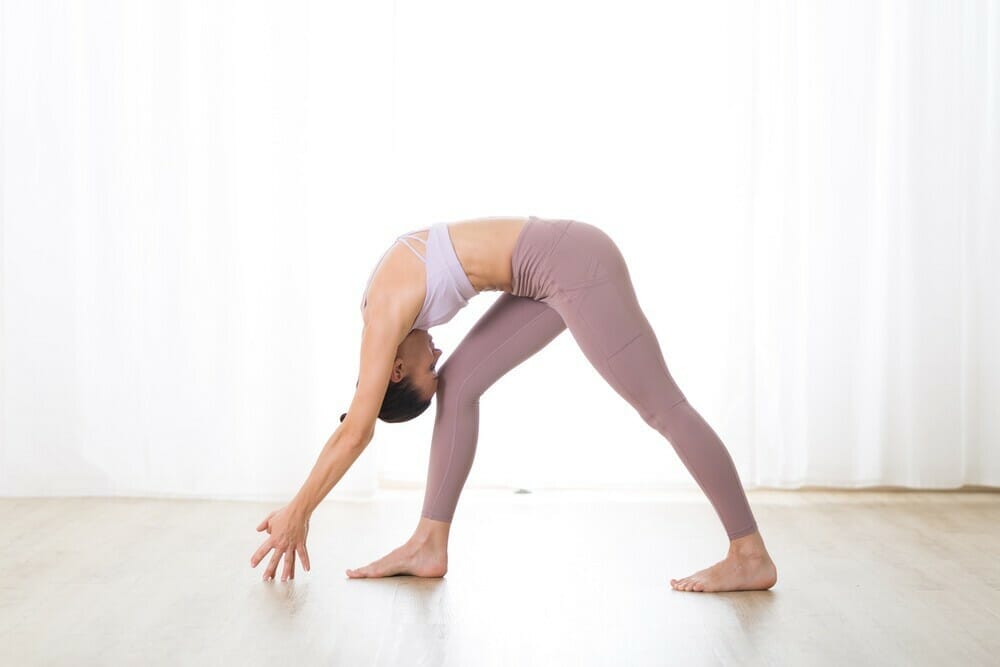
Benefits:
- Massages internal organs and stimulates the lymphatic system
- Improves flexibility in spinal joints
- Builds abdominal muscles
- Relieves sciatica and back pain
- Relieves diabetic disorders
- Slims belly, buttocks, hips, and waistline
- Helps regulate pancreas and revitalizes kidneys
TADASANA (TREE POSE)
The Tree Pose will get you back to balance. It improves a person’s posture while strengthening the joints of the ankles, knees, and hips.
As this pose helps improve balance, this allows the body to keep its stability.
Benefits:
- Tones abdomen, thighs, and buttocks
- Improves coordination and balance
- Relieves fatigue and stress
- Prevents hernia
- Relieves lower-back pain
- Releases tension in the belly
PADANGUSTASANA (TOE STAND POSE)
Practice makes perfect. The more you do yoga, the quicker you can bend your knee to sit on your heel. It also indicates that you feel confident enough in your knees to sit down.
Finally, it means that you have a strong foundation. You can do it!
Benefits:
- Strengthens the back and buttocks muscles
- Stimulates metabolism
- Helps relieve arthritis in hips and all leg joints
- Strengthens joints, stomach muscle, biceps, triceps, and shoulders
- Aids in curing gout and rheumatism
- Builds balance, concentration, core strength, focus, and patience
SAVASANA (DEAD BODY POSE)
Corpse Pose comes between the standing and seated series of bikram 26 poses sequence. Beyond being a calming exercise, it has a lot of benefits.
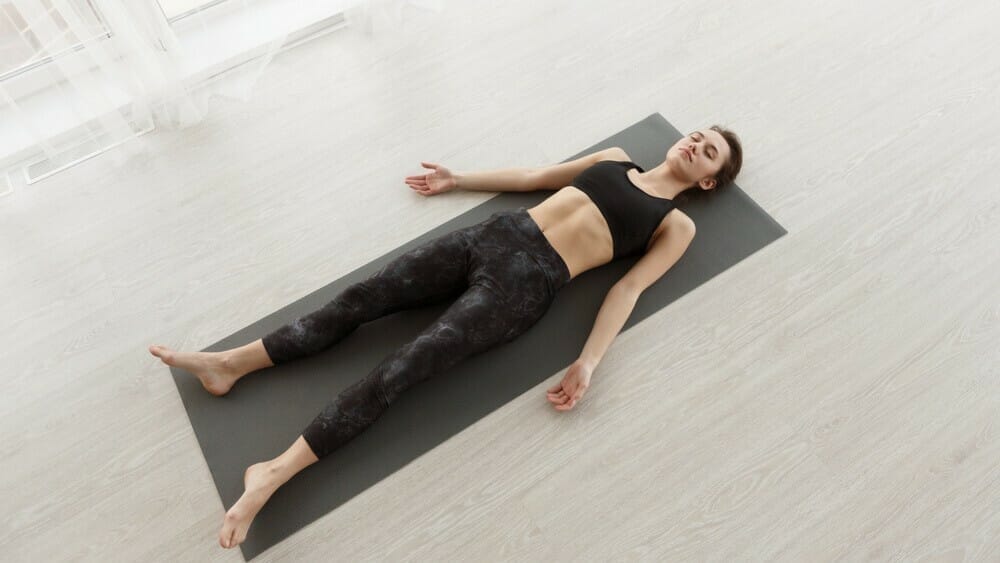
Benefits:
- Helps discharge body wastes
- Relieves stress and fatigue
- Strengthens abdominal organs
- Improves stamina
- May reduce high blood pressure
- Strengthens the immune system
- Optimizes circulation of freshly oxygenated blood to all areas of the body
- Calms mind reduces insomnia and improves sleep
PAVANAMUKTASANA (WIND REMOVING POSE)
In this pose, you lubricate your joints and massage your muscles for better digestion. It is the place where you feel mild pain in your hips.
It is because you pull your knees with force down towards your shoulders to stretch the spine to release your intervertebral discs.
Benefits:
- Relieves pain in hips
- Makes digestive system work better
- Increases flexibility
- Reduces pain in muscles and joints of the back
- Cures and prevents flatulence
- Regulates and normalizes levels of hydrochloric acid in the stomach
- Relieves lower back pain
- Stretches shoulders and entire backside of the spine
- Alleviates most chronic abdominal discomforts
- Firms and tones muscles of thighs, hips, and abdominal wall
Pada-Hasthasana (SIT UP)
This pose, Sit Up in bikram yoga 26 poses, is a great way to centre your mind and energize your body. It also stretches the muscles of the upper back and shoulders.
Head-to-Knee Pose is a variation of this pose that is often practised in other styles of yoga.
Benefits:
- Increases performance in the workplace and at school
- Improves posture
- Improves balance
- Massages abdominal organs
- Increases flexibility of hamstrings
- Strengthens and tightens abdominal muscles
- Tones torso
- Realigns spine and enhances its flexibility
BHUJANGASANA (COBRA POSE)
Cobra Pose (Bhujangasana) relaxes your back and helps you to ease into the rest of the yoga session.
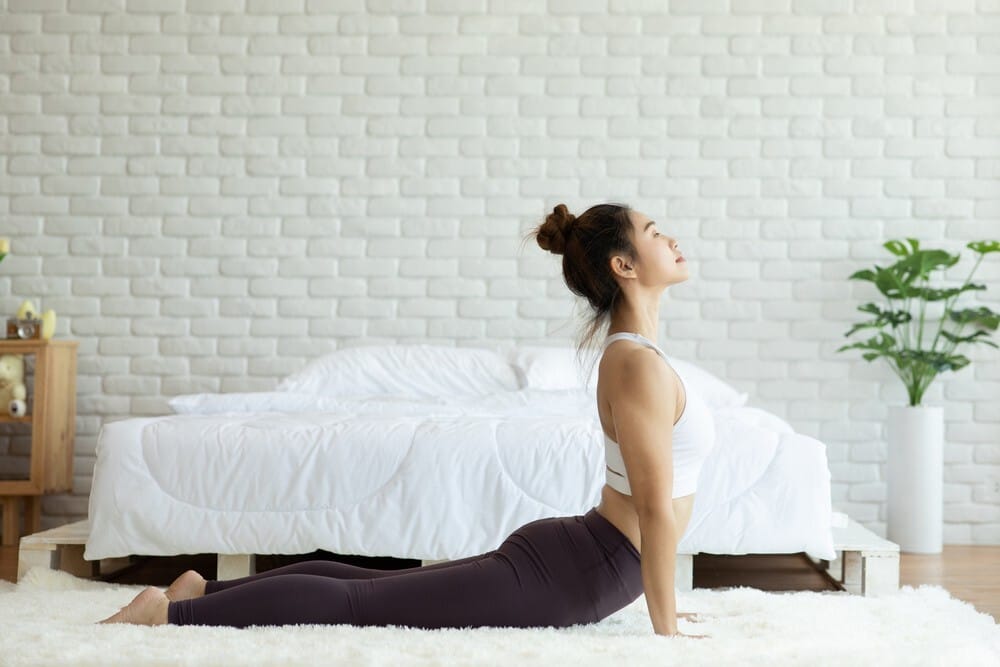
However, you should never forget to keep your butt tight throughout the poses, as that's where this muscle is anchored.
In the cobra position, you are strengthening your lower back.
Benefits:
- Improves spinal flexibility
- Improves posture
- Puts mind at ease
- Strengthens the abdominal muscles
- Increases flexibility of the spine
- Lengthens the body and stretches the entire backside of the spine
- Strengthens muscles of thighs, hips, and lower back
- Cures loss of appetite
- Boosts concentration
- Enhances the functioning of liver and spleen
SALABHASANA (HALF LOCUST POSE)
If you’re pushing yourself up from the ground, then your hip flexors are working.
This pose is done to stretch and lengthen your abdominal and groin muscles. In Salabhasana, you are gently pushing your hips forward.
Benefits:
- Strengthens abdominal muscles
- Tones thighs, buttocks, and chest
- Builds flexibility in the spine
- Cures tennis elbow
- Boosts circulation
- Builds core strength
- Invigorates arm and back muscles
POORNA – SALABHASANA (FULL LOCUST POSE)
The back is your power centre. Again, this pose gives you a chance to discover the strength and flexibility that lies there.
As in Cobra Pose, in Full Locust, you are pushing your hips backwards, but you are doing so more forcefully.
Benefits:
- Stretches the backside of the spine
- Strengthens abdominal muscles
- Lengthens the body
- Increases strength and flexibility in the lower back
- Improves function of liver and spleen
DHANURASANA (BOW POSE)
Continuing with backbends, Bow Pose is a great posture to open the chest and shoulders. It promotes a refreshing, supple feeling and improves the mobility of your spine.
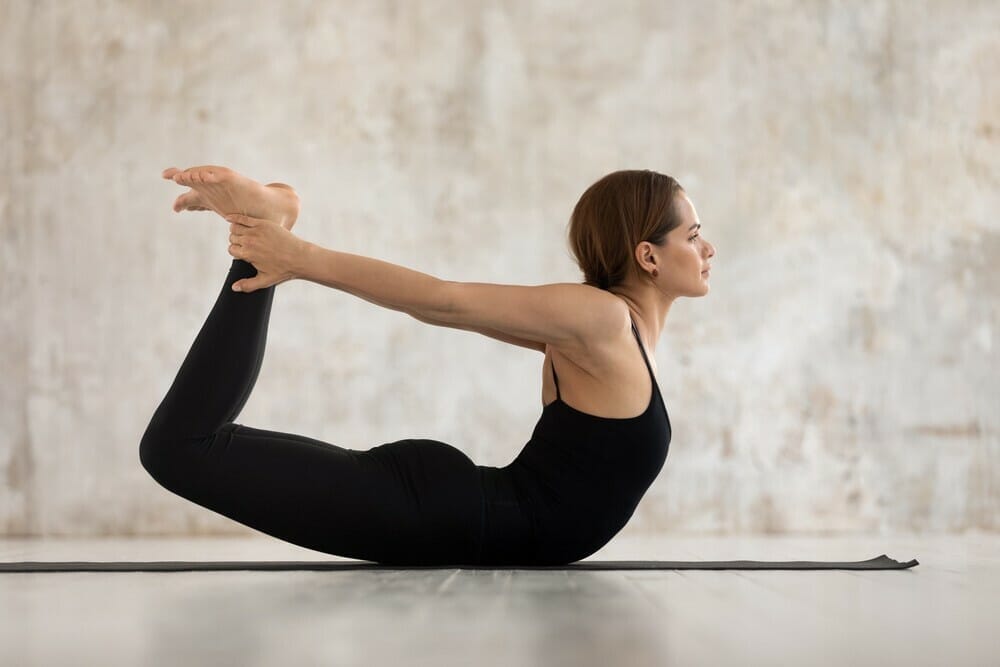
Benefits:
- Strengthens chest, shoulders, and legs
- Tones abdomen, lower back, and buttocks
- Relieves stress and anxiety
- Restores flexibility of the spine
- Boosts circulation to heart and lungs
- Enhances digestion
- Invigorates mental focus and perseverance
- Helps correct posture
- Improves oxygen intake by opening rib cage; this enables maximum expansion of lungs
SUPTA – VAJRASANA (FIXED FIRM POSE)
This posture is a great way to challenge your strength and flexibility. In this pose, all the muscles of your body are stretched.
It's a long and intense posture that'll help you stretch your hips, leg muscles, knee joint, ankles, lower back.
Benefits:
- Promotes flexibility in the tendons and ligaments of knees and ankles
- Strengthens abdominal muscles
- Relieves lower back pain
- Increases endurance
- Lubricates and increases circulation to joints
- Heals and improves weak or injured knees
- Tones thighs and calf muscles
- Lengthens and invigorates abdominal muscles
ARDHA – KURMASANA (HALF TORTOISE POSE)
In Half Tortoise Pose, you stretch your spine. Your shoulder joints are opened in the upper radius.
It gets your brain flushed with blood and activates your pineal gland for a better sleeping rhythm. Your sinuses are cleared, too.
Benefits:
- Stretches the spine, hips, and gluteal muscles
- Boosts blood circulation to the brain
- Massages spine and abdominal organs
- Strengthens abdomen
- Tones thighs
- Aids in relaxing body and mind
- Helps relieve digestion problems and constipation
USTRASANA (CAMEL POSE)
After seventy-five minutes of warming up, you can now perform the deepest backbend. This posture opens the heart chakra, where often emotions are hidden. Slowly but surely, you realize your inner light and get this pose.
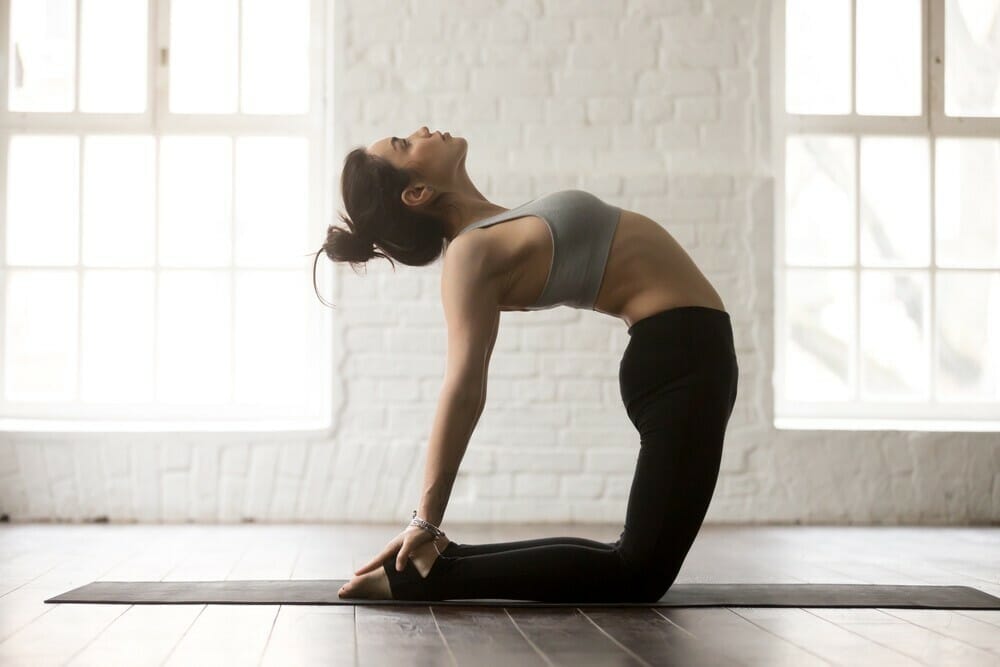
It lights up your heart. It is also helpful against depression.
Benefits:
- Strengthens abdominal muscles
- Lubricates joints
- Improves circulation
- Tones lower back, buttocks, and thighs
- Stimulates the nervous system
- Improves neck flexion
- Promotes elimination of toxins
- Extends throat, thyroid gland, and parathyroid glands
- Flushes blood through kidneys
SASANGASANA (RABBIT POSE)
Rabbit pose is an excellent release from backbends. Rock forward until your spine is as tight as possible. In this pose, pull firmly on your heels to relieve your neck and bend your low back the other way.
Benefits:
- Strengthens the backside of the spine and stretches the front side of your torso
- Improves circulation to the head and back
- Improves spinal flexibility
- Promotes improved digestive functioning
- Boosts energy levels
- Regulates metabolism
- Nourishes nervous system by maximally extending spine
- Enhances mobility and elasticity of back muscles and spine
JANUSHIRASANA – PASCHIMOTTHANASANA (HEAD TO KNEE WITH STRETCHING POSE)
Head-to-Knee Pose is combined with Stretching Pose (Janushirasana with Paschimottanasana) to provide optimal benefits.
In other forms of yoga, this pose is called Seated Head-to-Knee Pose.
Benefits:
- Tones thighs, buttocks, chest, arms, and shoulders
- Strengthens abdominal muscles
- Relieves compression of spinal nerves
- Improves blood circulation to heart and lungs
- Balances blood sugar levels and metabolism
- Boosts circulation to liver, pancreas, and spleen
- Expands solar plexus
- Strengthens biceps and quadriceps
- Nourishes kidneys and enhances kidney function
ARDHA – MATSYENDRASANA (SPINE TWISTING POSE)
It is the most important pose in the bikram yoga 26 poses. In this pose, you turn your spine 90 degrees. This pose is used for the Bikram Yoga logo worldwide.
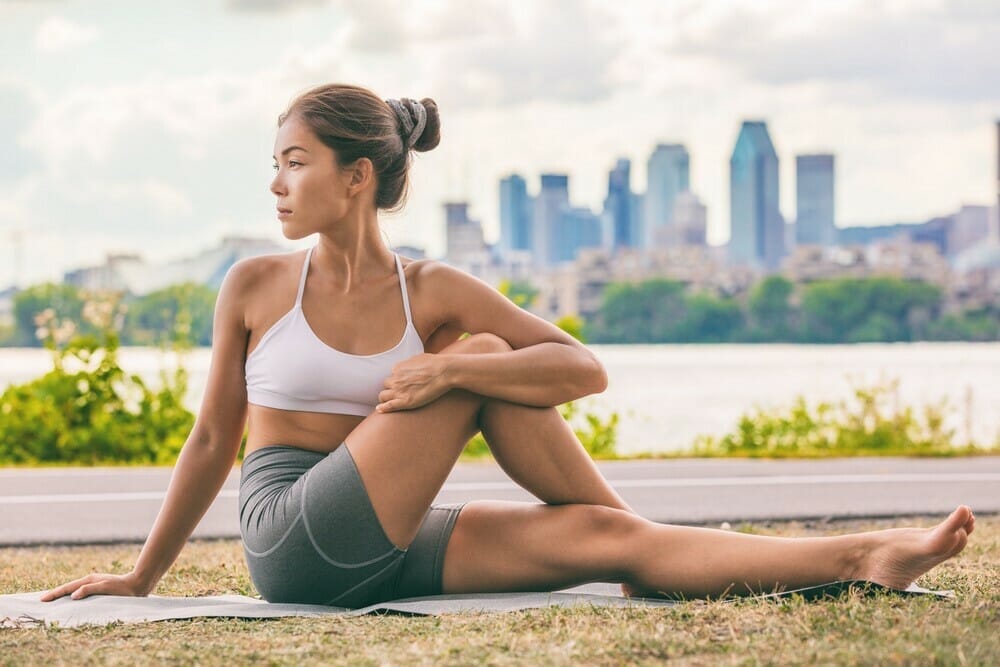
The spine is a long, flexible column of bones that stretches from the base of your skull to the end of your spinal cord.
It also realigns your intervertebral discs. Bikram says: “If you have a good backbone, your life flows and moves smoothly. You can reach for anything with ease.
Benefits:
- Strengthens entire body
- Locks out skeletal muscles to get the maximum stretch
- Improves circulation to all organs and glands
- Relieves stress and anxiety
- Makes spine supple and elastic
- Relieves lethargy, irritability, tension, depression, and insomnia
- Compresses and stretches spine from bottom to top
- Help prevent slipped discs, spinal rheumatism, scoliosis, kyphosis, cervical spondylosis, and arthritis
- Firms thighs, buttocks, and abdomen
- Opens shoulder joint
- Relieves lower back pain
KAPALBHATI IN VAJRASANA (BLOWING IN FIRM)
The bikram yoga 26 poses finishes in a kneeling posture and an exercise of breathing deeply. Specifically, it is the practice of Kapalbhati breathing that is done in Vajrasana.
Benefits:
- Opens and strengthens lungs
- Increases oxygen supply to brain and organs
- Stimulates circulation and brings relief from fatigue
- Improves digestion, assimilation, and elimination
- Tones and strengthens abdominal organs
- Relieves chronic respiratory disorders, coughs, asthma, bronchitis, emphysema, heart palpitations.
Dead Body Pose | Savasana
It is the last thing you do in class, and it’s essential to getting the benefits from your yoga practice—the same as the one you do when you’re on your back. However, the deviation is that your eyes are closed.

Take your time, sit down, and breathe deeply. Relax your muscles and let go of any tension in your body for at least two minutes.
This moment is when your mind and body are processing what you accomplished for the entire lesson.
Conclusion On Bikram Yoga 26 Poses
If you’re a devotee of Bikram yoga, you will be familiar with the detailed movements outlined above.
Many of these hot 26 yoga poses are derived from hatha yoga and are designed to increase flexibility in the body.
They require no equipment, just your own body and an open mind.
While many people would argue that intense bikram hot yoga sequence can have some adverse effects, such as muscle strains and a quicker heart rate, there are many positive things about it too.
It can be beneficial for people who have illnesses or injuries that make it challenging to exercise normally. The positive effects don't just end after your practice ends.
Many yoga practitioners report that the positive impact of bikram yoga postures continues as they go about their daily routines.
Some say it helps them focus and stay calm, while others find that it allows them to sleep better in the evenings.
That’s about it, yogis! Everything you need to know about the bikram yoga 26 poses sequence and its postures. Namaste!


